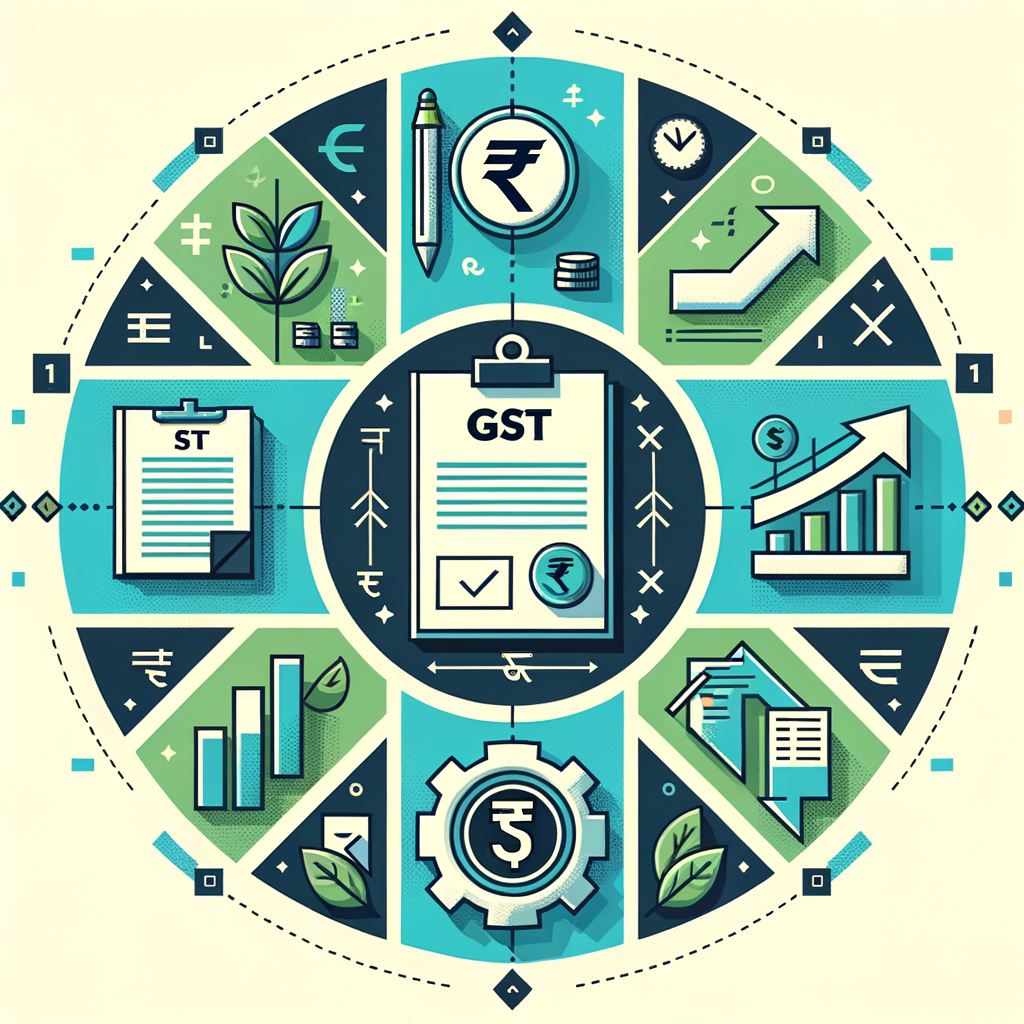GST ITC Claim – What Changed After Latest CBIC Circular?
Meta Description: Stay updated on the latest GST ITC updates 2023. Our guide breaks down the recent CBIC circular, explaining the new rules for your GST ITC claim and how it impacts small businesses in India. Learn to stay compliant and maximize your credit.
For any small or medium-sized business in India, mastering the GST ITC claim is not just about compliance; it’s a critical financial strategy for maintaining healthy cash flow. Input Tax Credit (ITC) is the backbone of the GST system, preventing the cascading effect of taxes and reducing the financial burden on businesses. However, the GST landscape is constantly evolving. The Central Board of Indirect Taxes and Customs (CBIC) frequently issues notifications and circulars to streamline processes and tighten compliance. A recent circular has introduced significant changes to the GST ITC claim process in India, making it more automated and stringent. This post will demystify the latest CBIC circular impact on GST, break down the new rules, and provide a clear, step-by-step guide to ensure your business remains compliant and continues to make successful GST claims for businesses in India. Keeping up with these GST ITC updates 2023 is essential for seamless business operations.
Understanding the Basics: What is a GST ITC Claim?
Before diving into the new changes, it’s crucial to have a solid grasp of the fundamentals. The concept of Input Tax Credit is what makes GST a value-added tax. Understanding GST ITC after CBIC circular changes begins with knowing what ITC is at its core. It is the mechanism that allows a business to reduce the tax it pays on its sales (output tax) by the amount of tax it has already paid on its purchases (input tax). This prevents “tax on tax,” ensuring that tax is levied only on the value added at each stage of the supply chain. A clear understanding of this principle is vital for any business owner, as it directly impacts product pricing, profitability, and working capital management. Without ITC, the final cost to the consumer would be significantly higher, and businesses would face a much heavier tax burden, stifling growth and economic activity.
A Quick Refresher on Input Tax Credit (ITC)
Let’s break down ITC with a simple example. Imagine you are a baker registered under GST.
- You purchase raw materials like flour, sugar, and butter for ₹1,000. On this purchase, you pay a GST of 5%, which amounts to ₹50. This ₹50 is your input tax.
- You use these materials to bake a batch of cakes, which you sell for ₹2,500. On this sale, you collect a GST of 5% from your customers, which amounts to ₹125. This ₹125 is your output tax liability.
When it’s time to pay your taxes to the government, you don’t need to pay the full ₹125. You can claim the ₹50 you already paid on your inputs as a credit. Therefore, your final GST payment to the government will be:
₹125 (Output Tax) – ₹50 (Input Tax Credit) = ₹75
This credit can be claimed against the different components of GST—Central GST (CGST), State GST (SGST), and Integrated GST (IGST)—based on a specific set of rules for cross-utilization, further optimizing your tax payments.
Who is Eligible to Make a GST ITC Claim in India?
Claiming ITC is not an automatic right; it is subject to specific conditions laid out in the GST law. To be eligible, a business must meet all the following criteria:
- GST Registration: The business must be registered under the GST Act. An unregistered person cannot claim ITC.
- Possession of Tax Invoice: You must have a valid tax invoice, debit note, or other prescribed tax-paying documents issued by your supplier.
- Receipt of Goods or Services: You must have actually received the goods or services for which you are claiming the credit.
- Supplier’s Tax Payment: The tax charged on your purchases must have been paid to the government by your supplier. This is a critical condition and a common reason for ITC disputes.
- Filing of Returns: You must have filed your GST returns, specifically the GSTR-3B, where the ITC is claimed.
For a comprehensive list of all conditions and detailed eligibility criteria, taxpayers can refer to the official GST Portal.
The Game Changer: Unpacking the Latest CBIC Circular on GST ITC
The GST Council and the CBIC are consistently working towards creating a more transparent and data-driven compliance ecosystem. The latest circular is a significant step in this direction, aiming to curb fraudulent claims and enforce discipline in reporting. The primary focus of these changes in GST ITC claims in India is to ensure that the ITC a taxpayer claims in their GSTR-3B return is in complete harmony with the credit that is auto-populated in their GSTR-2B statement. This move from manual oversight to an automated, system-driven check has profound implications of a CBIC circular on GST ITC, making accuracy and diligence non-negotiable for all businesses.
Identifying the Circular: What’s New?
The key change was officially introduced via CBIC Circular No. 199/11/2023-GST, dated 17th July 2023. This circular operationalizes Rule 88D of the CGST Rules, 2017.
The main purpose of this circular is to establish a systematic and automated mechanism for dealing with discrepancies between the Input Tax Credit claimed in Form GSTR-3B (the summary return) and the ITC available as per Form GSTR-2B (the auto-drafted ITC statement).
Key Change 1: Automated Scrutiny of Mismatches
The introduction of Rule 88D marks a major shift in how the GST system scrutinizes returns. Previously, mismatches were often identified during audits or manual assessments. Now, the GSTN portal itself is programmed to perform this check automatically for every tax period.
The system will compare the ITC you claim in Table 4 of your GSTR-3B with the ITC that is available in your GSTR-2B. If the amount claimed in GSTR-3B exceeds the available amount in GSTR-2B by a predefined threshold (in terms of amount or percentage, as decided by the GST Council), the system will automatically flag it as a discrepancy. This automated scrutiny means there is no place to hide. Any variance, whether intentional or accidental, will be immediately detected, triggering the next step in the compliance process.
Key Change 2: The New Intimation Process (Form GST DRC-01C)
Once a mismatch is flagged by the system, the taxpayer will receive an automated intimation on the GST portal. This new process is designed to be swift and requires an immediate response.
- Intimation in Form GST DRC-01C: The taxpayer receives a system-generated notice in Part A of Form GST DRC-01C. This form will clearly state the tax period, the amount of excess ITC claimed, and the difference between the GSTR-3B and GSTR-2B figures.
- Mandatory Response within Seven Days: Upon receiving this intimation, the taxpayer is given a strict timeline of seven working days to respond. Failure to act within this period can lead to serious consequences.
- Two Response Options: The taxpayer must choose one of the following two courses of action:
- Accept and Pay: If the taxpayer agrees that they have claimed excess ITC in error, they must pay the excess amount, along with applicable interest under Section 50 of the CGST Act, through Form GST DRC-03. After payment, the details of the payment ARN (Application Reference Number) must be furnished in Part B of Form GST DRC-01C.
- Explain the Difference: If the taxpayer believes the ITC claimed is correct and there is a valid reason for the discrepancy, they must provide a detailed justification in Part B of Form GST DRC-01C. Valid reasons could include scenarios like ITC not reflecting in GSTR-2B due to a supplier’s delay in filing GSTR-1 for a previous period, which is now being claimed.
This new, time-bound process demands that businesses be more vigilant and responsive than ever before.
How to Master the New GST ITC Claim Process in India: A Step-by-Step Guide
Navigating these new rules requires a proactive and systematic approach. The days of filing GSTR-3B based on purchase records alone are over. Here is a practical, step-by-step guide to help your business master the new GST ITC claim process in India and avoid any compliance issues.
Step 1: Prioritize Diligent Vendor Communication and Invoice Matching
The entire ITC system now hinges on your supplier’s compliance. If your supplier fails to file their GSTR-1 on time or reports your invoice incorrectly, the credit will not appear in your GSTR-2B. This means you cannot claim it without triggering a notice. It is therefore essential to establish a robust process for vendor management. Regularly communicate with your suppliers to ensure they are filing their returns by the due dates. Before making payments, cross-check that the corresponding invoices are reflected in your GSTR-2A/2B. Make timely compliance a key criterion when selecting and evaluating your vendors.
Step 2: Reconcile GSTR-2B with Your Purchase Records Religiously
Your GSTR-2B statement is now the definitive document for ITC eligibility. It is a static statement generated for each tax period that provides a detailed breakdown of all the input tax credit available to you. Before you even begin to file your GSTR-3B, you must perform a thorough ITC reconciliation of your purchase register with the data in your GSTR-2B. This exercise will help you identify any missing invoices or discrepancies. Your GST ITC claim in GSTR-3B should ideally be equal to the total eligible credit available in your GSTR-2B. Claiming a higher amount should only be done if you have an exceptionally valid and documentable reason.
Step 3: Filing GSTR-3B with Unmatched Accuracy
When filing your GSTR-3B, the GST portal auto-populates the ITC figures directly from your GSTR-2B. Do not blindly accept these figures. You must meticulously verify them against your own reconciled data. Ensure that the final figures you submit in Table 4 of your GSTR-3B are accurate and fully backed by your GSTR-2B and purchase records. Arbitrarily overriding the auto-populated data with a higher figure without a solid reason is the quickest way to receive a notice in Form GST DRC-01C. Accuracy is no longer just good practice; it’s a mandatory requirement to avoid scrutiny.
Step 4: Actively Monitor for and Respond to Notices
Proactive monitoring is crucial. Make it a regular habit to log into the GST portal and check for any intimations or notices, especially under the “Notices and Orders” tab. Do not rely solely on email or SMS alerts, as they can sometimes be missed. If you receive an intimation in Form GST DRC-01C, you must act immediately. As explained, you have only seven days to respond. Ignoring this notice is not an option. Failing to respond can lead to the tax department initiating recovery proceedings for the disputed amount and may also result in your GSTR-1 filing for subsequent periods being blocked, effectively halting your business operations.
Conclusion
The latest updates surrounding the GST ITC claim process signal a clear message from the tax authorities: the GST regime is maturing towards a system of complete automation, transparency, and strict compliance. For businesses, this means that a proactive, disciplined, and technology-driven approach to GST compliance is no longer optional—it is essential for survival and growth. The core principles remain simple but require unwavering attention. You must reconcile your purchase data with GSTR-2B meticulously, maintain open communication with your suppliers, and respond to any departmental notices with urgency and accuracy. Embracing these practices will not only keep you compliant but also protect your valuable cash flow.
Feeling overwhelmed by the changes in GST ITC claims in India? TaxRobo’s expert GST services can help you navigate these complexities, ensure compliance, and maximize your ITC. Contact us today for a consultation!
GST Claim FAQs
1. What happens if I don’t respond to an intimation in Form GST DRC-01C for my GST ITC claim?
If you fail to respond within the stipulated seven-day timeframe, the GST system is designed to take further action. The disputed ITC amount, which was flagged as excess, may be considered a confirmed tax liability. Consequently, the tax department can initiate recovery proceedings under Section 79 of the CGST Act to recover this amount from you. Furthermore, under Rule 59(6), your facility to file Form GSTR-1 or use the Invoice Furnishing Facility (IFF) for the subsequent tax period may be blocked until you resolve the matter.
2. Can I still claim ITC for an invoice that my supplier hasn’t uploaded in their GSTR-1?
Legally, you are entitled to the credit if you satisfy all the conditions under Section 16 of the CGST Act (e.g., you have the invoice, you’ve received the goods/services). However, under the new automated regime, you cannot practically claim this ITC in your GSTR-3B until the credit appears in your GSTR-2B. If you do claim it, it will result in a mismatch and you will receive a notice in Form DRC-01C. The correct course of action is to relentlessly follow up with your supplier to ensure they file their GSTR-1 correctly and report the invoice, so the credit reflects in your GSTR-2B for a future period, at which point you can claim it.
3. What is the best practical tip for a small business to manage these GST ITC updates?
The single most effective tip for a small business is to adopt technology. Use a reliable accounting or GST filing software that can integrate with the GST portal. Such software can automate the reconciliation of your purchase register with GSTR-2B, highlighting mismatches in real-time. This drastically reduces the time and effort required for manual checks and minimizes the risk of human error that could lead to notices. Combining technology with a disciplined monthly routine of reconciliation and vendor follow-up is the key to managing your GST ITC claim seamlessly.



